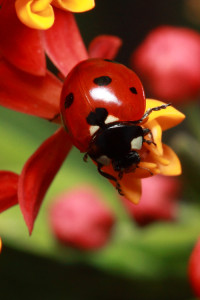
Seven spotted lady beetle on milkweed
The annual ladybug invasion appears to be in motion.
Reports of ladybird beetles, commonly known as ladybugs, invading homes and structures across the southern U.S. have raised questions and concerns.
According to a Texas A&M AgriLife Extension Service expert, ladybugs are definitely a friend, but sometimes even friends can wear out their welcome.
Wizzie Brown, AgriLife Extension integrated pest management specialist, Austin, said the increased sightings of ladybugs inside homes and structures are related to colder temperatures. They are crawling through cracks and crevices around the home to find warm, dry spots as temperatures outside drop.
Brown said ladybugs are a beneficial insect to gardeners. They are an effective predator against soft-bodied insect pests like aphids that can affect ornamental plants and devastate fruit and vegetable production.
“If they’re outside and not bothering you, it’s best to just leave them alone,” she said. “Having them overwinter around your home means it’s likely you will have good populations present when garden pests start emerging in the spring.”
Native ladybugs versus the Asian lady beetle
Despite their benefits outside, ladybugs can be a nuisance when they invade homes, she said. They can stain fabrics and are smelly when they die or when they release a fluid used as a defense mechanism. Sometimes, when they feel threatened, ladybugs can bite.
Native ladybugs prefer to hibernate outside, but their counterparts, the Asian lady beetle, prefer indoors, so it is likely that invading beetles are the invasive species, Brown said. Native ladybugs and Asian lady beetles are different species. Aside from their overwintering preferences, provide the same benefits around vegetable gardens and landscapes.
Both native and Asian ladybugs can share similar colors and spots, Brown said. Asian ladybugs can be identified by a small M or W, depending on how you look at them, on the shield-like section behind their head.
“They are both ladybird beetle species, and while the Asian species tends to be a brownish-red or orange with spots, they can also be red with spots,” she said. “So, the best way to differentiate them is the M or W.”
How to remove ladybugs from my home
If ladybugs are moving indoors in very large numbers, Brown said, homeowners can easily remove them and practice exclusion methods around the home to prevent future entry.
Brown suggests sucking them up with a vacuum cleaner and either bagging them for the trash or releasing them outside.
To prevent ladybugs from entering a building, Brown suggests exclusion methods, including:
- Pruning trees and shrubs back away from the house or roof.
- Moving firewood or other items that might harbor insects away from the house.
- Installing weather stripping around loose-fitting doors and windows.
- Blocking weep holes in brick or stone facades.
- Using caulk or expanding foam to fill cracks and crevices on the outside of the house and around pipe and wire penetrations.
- Keeping window screens in good repair.
- Using stainless steel mesh wire to block potential access points in the attic, including vents.
“Ladybird beetle invasions are very sporadic,” she said. “If you’ve had an issue before, it is likely to happen again, but environmental conditions and what is going on around the house play a big role in their activity from year to year. The good thing is, if you practice the exclusion methods, you’re going to prevent other insect pests that might be looking for shelter this time of year from entering your home.”
Are ladybugs harmful to pets?
Brown said pet owners should not worry about ladybugs poisoning their animals. A story and photo that continues to circulate on the internet about a dog with the ladybugs in its mouth is about one instance.
“Apparently the dog was one that eats anything and everything, and it got into a large number of ladybird beetles,” she said. “Some ladybugs were clamping down in its mouth and releasing their defensive fluid trying to avoid being eaten, so you get the viral photo and subsequent panic among pet owners. But veterinarians have tried to dispel any hysteria and agree there is really very little concern about their toxicity beyond some possible stomach irritation.”
Written By Adam Russell, Texas A&M AgriLife Extension Communication Specialist
